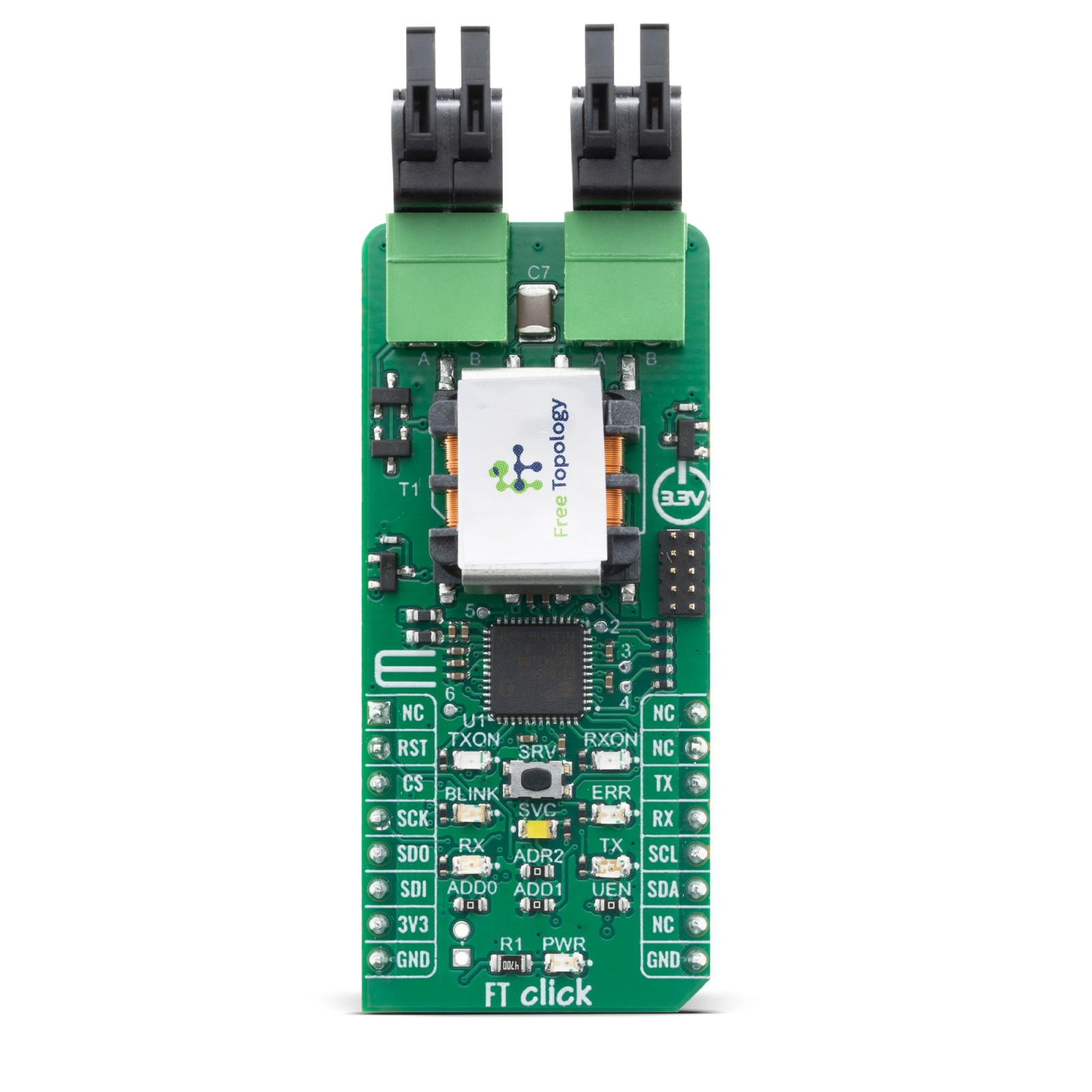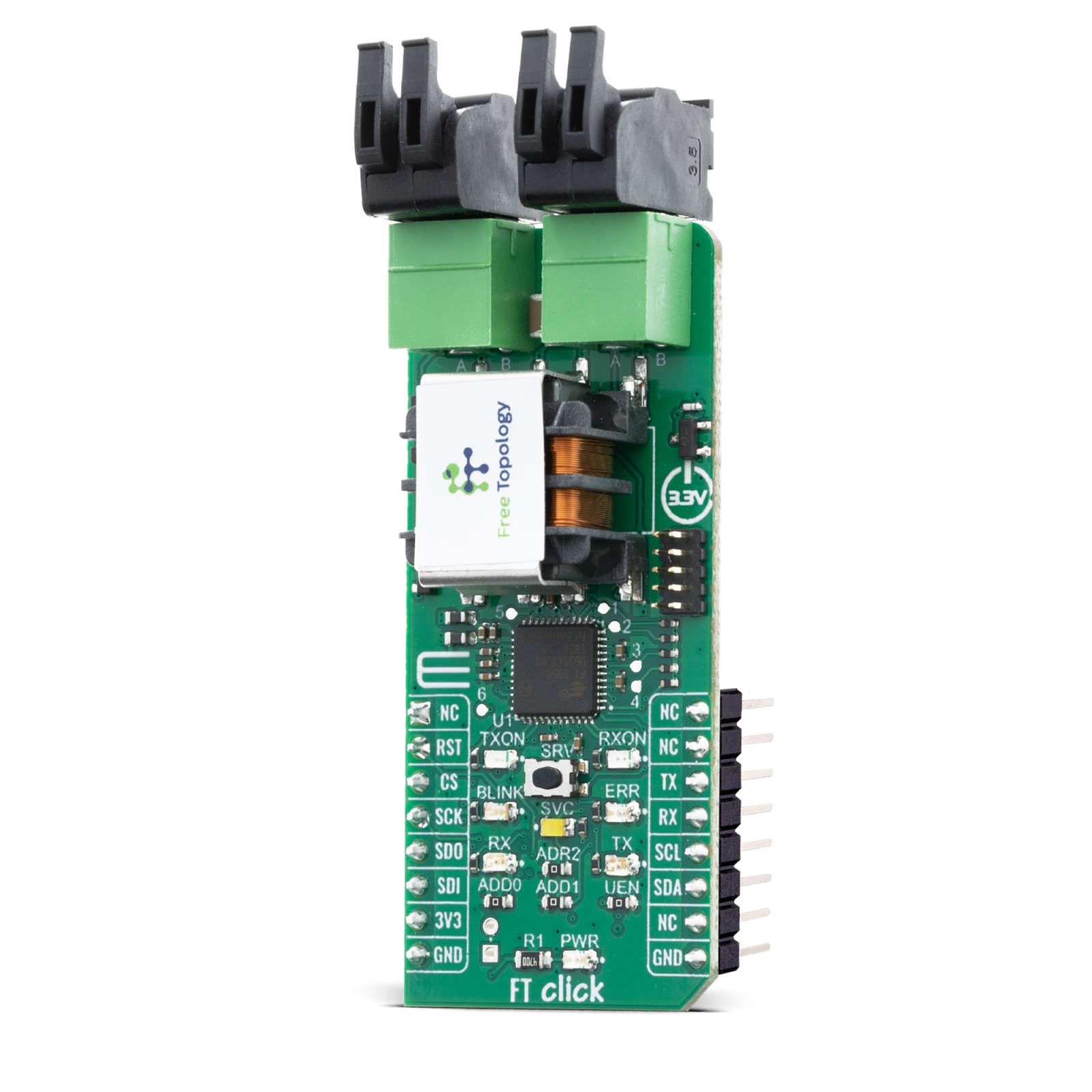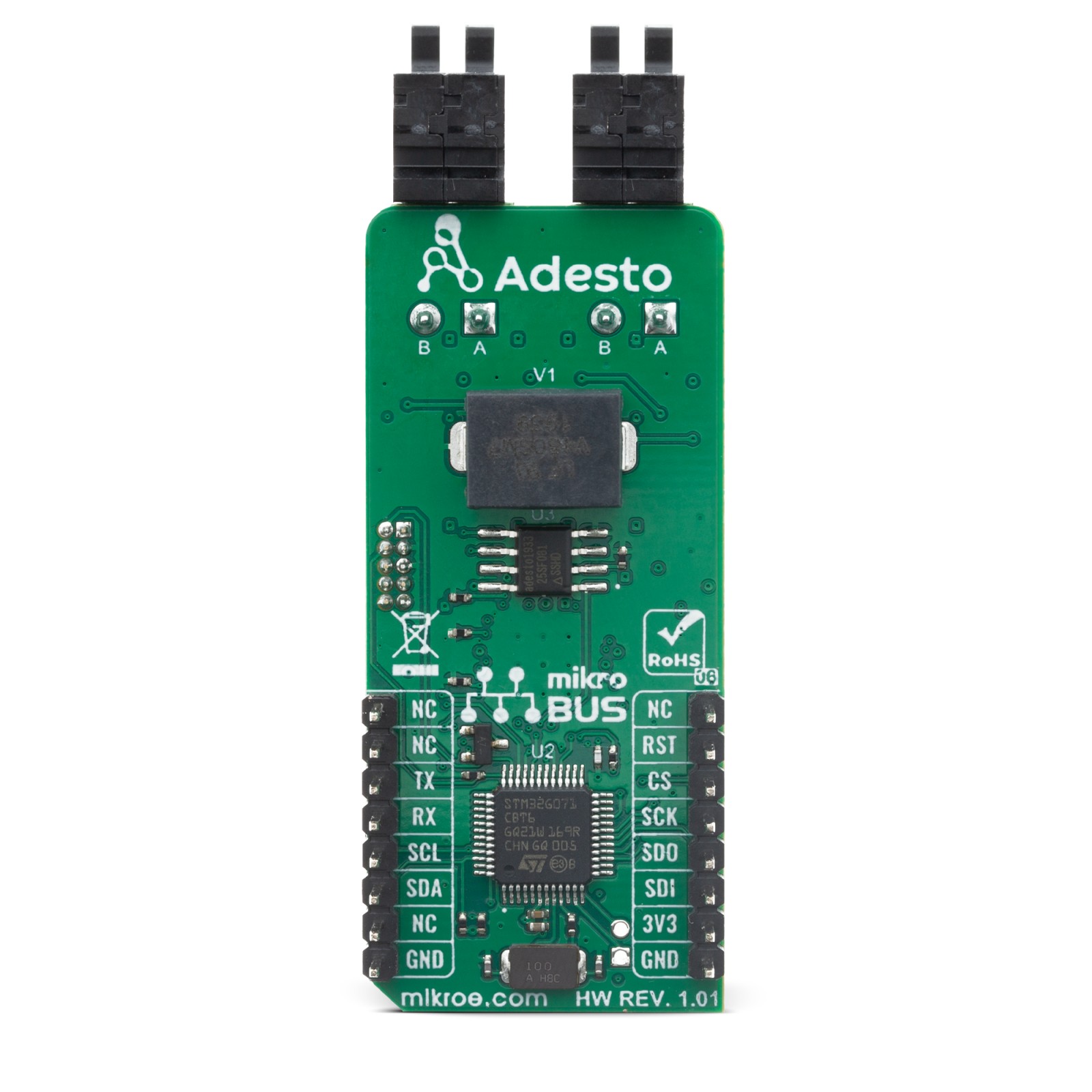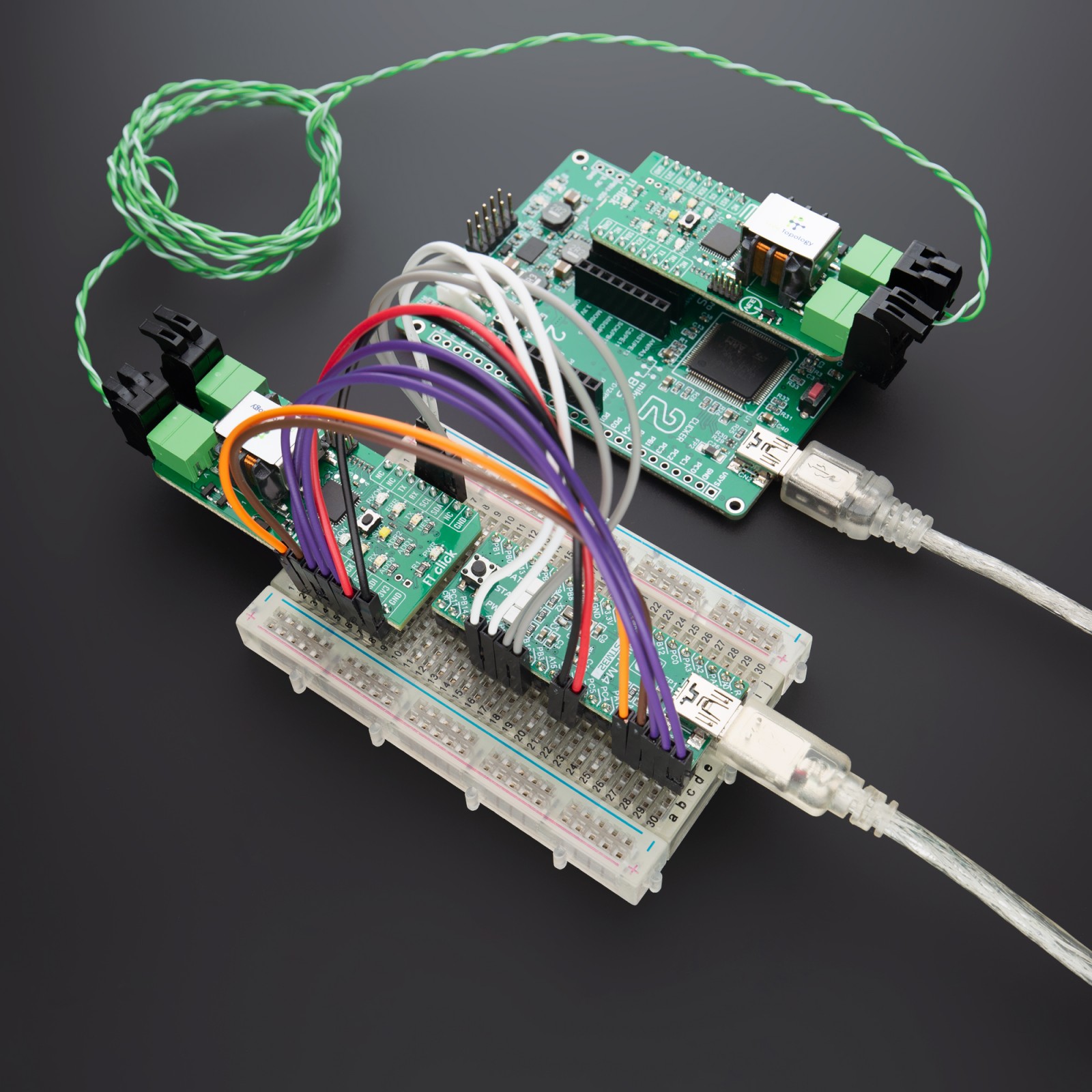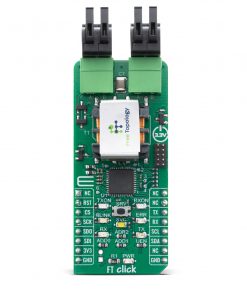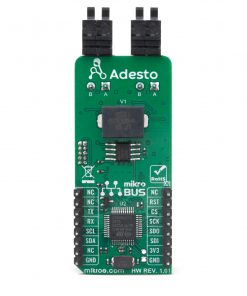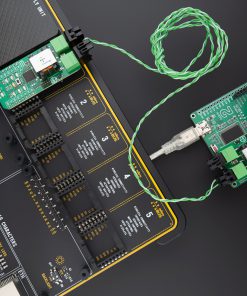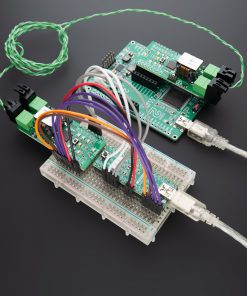FT Click
R990.00 ex. VAT
FT Click is a compact smart transceiver add-on board that helps you add a Free Topology (FT) interface to any host board with the mikroBUS™ socket. Leveraging FT, the most reliable and easiest-to-scale wired communications media, FT Click lets you network sensors and devices to create IoT solutions for automation and control networks that are easier to develop, integrate and install. This Click board™ supports full communication stacks for LON® and BACnet FT, as well as FTMQ (MQTT like messaging format) on board to simplify integration of BACnet, LON or custom IoT networks over twisted pair wire. FT Click is ideal for markets including smart buildings, cities, machines, agriculture, manufacturing, transportation and many more where wireless communications do not provide the required reliability and scale.
FT Click is supported by a mikroSDK compliant library, which includes functions that simplify software development. This Click board™ comes as a fully tested product, ready to be used on a system equipped with the mikroBUS™ socket.
Stock: Lead-time applicable.
| 5+ | R940.50 |
| 10+ | R891.00 |
| 15+ | R841.50 |
| 20+ | R809.82 |
How does it work?
The FT 6050 by Renesas transceiver is designed to simplify integration and maintenance of a complete system, and supports polarity-insensitive cabling using star, bus, daisy chain, loop, or combined topologies. The flexibility of Free Topology wiring frees the installer from the need to adhere to a strict set of wiring rules, reducing the time and expenses of device installation. It also simplifies network expansion by eliminating restrictions on wire routing, splicing, and device placement.

The FT Click works as the communication layer for any embedded application. The main component is the system-on-chip FT 6050 smart transceiver, which combines strengths of BACnet and LON for the first time in one solution. In addition to the transceiver, on this board we have several other building blocks from Dialog including the FT-X3 communications transformer which provides reliable communication without interference, and external AT25SF081 flash memory for storing additional resources for the FT 6050. In addition, the board also features an STMicroelectronics microcontroller whose role is to hold network custom stacks and APIs that are interpreted through the FT transceiver.
The FT 6050 chip includes multiple processors, read-write and read-only memory (RAM and ROM), communication subsystems, and I/O subsystems. Each FT 6050 chip includes a processor core for running applications and managing network communications, memory, I/O, and a 48-bit identification number (the Neuron ID) that is unique to every device. FT 6050 devices simultaneously provide a LON, LON/IP, BACnet/IP Server, BACnet MS/TP server, and messaging interface.
As mentioned, the FT Click uses an external AT25SF081 flash of 8Mb for storing additional resources for the FT 6050. This flash contains active and standby bootloaders, system images, and applications. It also holds persistent system and application data, as well as data logs. Larger applications can be supported because certain code can be designated to be “transient” which means it is brought into RAM for execution out of flash only on demand.
The FT-X3 external communication transformer enables operation in the presence of high frequency common-mode noise on unshielded twisted-pair networks. The transformer also offers outstanding immunity from magnetic noise, eliminating the need for protective magnetic shields in most applications ensuring robust communication.
The FT Click interface supports all two-wire “Free Topology” twisted-pair networks with polarity-insensitive star, daisy chain, bus, loop, trunked, or mixed topology wiring with very high noise immunity.
Summary of Benefits of FT Click:
- Simple messaging (FTMQ) to full IP based network communications stacks (BACnet and LON) on same board
- Easy to install, fault tolerant, error free communication media using Dialog’s Free Topology technology and FT 6050 Smart Transciever
- Highly reliable and scalable communication alternative to wireless protocols
- Lowest cost of ownership and installation compatred to wired protocols such as RS485 and Ethernet
- Works with any mikroBUS compatible development boards, sensors and devices
Software Stack
There are 3 basic sets of APIs included in the FT click software libraries: “FTMQ”, BACnet and LON. These source code libraries support multiple development platforms such as ST M32 Nucleo, Arduino and Raspberry Pi.
The simplest “MQTT-like” protocol called FTMQ provides a familiar interface for subscribing to, and publishing, messages on topics, without requiring a broker (but otherwise very similar to MQTT). The intent of this protocol is to enable a quick-as-possible and familiar startup without need for further setup such as device ID or station address. Also provided is a FTMQ-to-MQTT bridge that runs on a R-Pi or other Linux platform to upconvert this protocol to fully compliant MQTT messaging.
For users considering using the FT6050 chip in embedded OEM designs utilizing BACnet and LON protocols, there are multiple options.
BACnet stack using FT as the data link (BACnet FT) supports BACnet configurations such as Routing, Alarming, COVs, Segmentation, BACnet/IP, BACnet/SC, and BACnet MS/TP is available from ConnectEx, Inc.
BACnet stack using FT as the data link (BACnet FT) supports BACnet configurations such as Routing, Alarming, COVs, Segmentation, BACnet/IP, BACnet/SC, and BACnet MS/TP is available from ConnectEx, Inc.
For either LON or BACnet support, please contact:
- support.renesas.com (LON development)
- info@connect-ex.com (BACnet development)
Specifications
Type
Free Topology,RS485
Applications
Ideal for markets including smart buildings, cities, machines, agriculture, manufacturing, transportation and many more where wireless communications do not provide the required reliability and scale.
On-board modules
FT 6050 Free Topology Smart Transceiver integrates a high-performance Neuron core with a Free Topology twisted pair transceiver, FT-X3 is external communication transformer that enables operation in the presence of high frequency common-mode noise
Key Features
Multi drop free topology fieldbus supporting 64 devices per channel; Polarity insensitive, isolated, and highly fault or noise tolerant; 78 kbps up to 500m (using free topology) and 2700m (using terminated bus); Unique IDs and automatic addressing scheme available; Supports link power; Uses inexpensive twisted pair wiring
Interface
I2C,SPI,UART
Feature
No ClickID
Compatibility
mikroBUS™
Click board size
L (57.15 x 25.4 mm)
Input Voltage
3.3V
Pinout diagram
This table shows how the pinout on FT Click corresponds to the pinout on the mikroBUS™ socket (the latter shown in the two middle columns).
Onboard settings and indicators
| Label | Name | Default | Description |
|---|---|---|---|
| T2 | SRV | – | Allows individual devices to be identified, and/or bound, on a network of perhaps hundreds or thousands of devices |
| LD1 | PWR | – | Power LED Indicator |
| LD2 | TX | – | FT Click to Host Microcontroller packet sent |
| LD3 | RX | – | Host Microcontroller to FT Click packet received |
| LD4 | ERR | – | Error LED indicating possible errors, system, network or other(under user control) |
| LD5 | BLINK | – | Heartbeat LED showing operational status of the module (under user control) |
| LD6 | SVC | – | Flashes in accordance to the FT6050 documentation to indicate the state of the FT6050 chip on the network. Normally OFF and will only be used in advanced use-case scenarios. Also used to identify a given FT6050 device on the network by using the “Wink” command, either from the FT network side using LON tools, or via the host application layer. |
| LD7 | TXON | – | Transmit packet on FT Network sent |
| LD8 | RXON | – | Incoming packet from FT Network received |
| R7 | UEN | Populated | UART enable |
| R8,R9,R10 | – | Populated | I2C Address |
Software Support
We provide a library for the FT Click on our LibStock page, as well as a demo application (example), developed using MikroElektronika compilers. The demo can run on all the main MikroElektronika development boards.
Library Description
The library contains functions to provide communication between 2 or more click boards.
Key functions:
void ft_send_package( uint8_t *data_buf, uint16_t len, uint8_t queue )– Sends full package to other modulevoid ft_process ( uint8_t rsp_data )– Collecting and preserving data received via uart interrupt routineuint16_t ft_get_data ( uint8_t *data_buf )– Gets new received data
Examples description
The application is composed of three sections :
- System Initialization – Initialize UART module and sets aplication mode (RX or TX)
- Application Initialization – Initialize driver init
- Application Task – RX mode : Reads and logs new receive data. TX mode : sends (MikroE) data every 1 seconds.
void application_task ( )
{
if ( app_mode == APP_MODE_RX )
{
if ( ft_get_data_status( ) == FT_NEW_DATA_AVAILABLE )
{
rsp_data_num = ft_get_data( &rsp_data_buf[ 0 ] );
if( rsp_data_num != 0 )
{
mikrobus_logWrite( "---------------------------", _LOG_LINE );
mikrobus_logWrite( "--> READ: ", _LOG_TEXT );
mikrobus_logWrite( rsp_data_buf, _LOG_LINE );
mikrobus_logWrite( "---------------------------", _LOG_LINE );
}
}
}
else
{
mikrobus_logWrite( "--------------------------", _LOG_LINE );
mikrobus_logWrite( "--> SEND MIKROE DATA <--", _LOG_LINE );
mikrobus_logWrite( "--------------------------", _LOG_LINE );
ft_send_package( &MIKROE_DATA_BUF[ 0 ], MIKROE_DATA_BUF_LEN, MIKROE_DATA_QUEUE );
Delay_ms( 1000 );
}
}
Note – Before the start program check uart interrupt routine in the Click_FT_other peripherals file.
The full application code, and ready to use projects can be found on our LibStock page.
Other mikroE Libraries used in the example:
- UART Library
- Conversions library
Additional notes and informations
Depending on the development board you are using, you may need USB UART click, USB UART 2 click or RS232 click to connect to your PC, for development systems with no UART to USB interface available on the board. The terminal available in all MikroElektronika compilers, or any other terminal application of your choice, can be used to read the message.
mikroSDK
This Click board™ is supported with mikroSDK – MikroElektronika Software Development Kit. To ensure proper operation of mikroSDK compliant Click board™ demo applications, mikroSDK should be downloaded from the LibStock and installed for the compiler you are using.
For more information about mikroSDK, visit the official page.
Resources
Downloads
| Weight | 32 g |
|---|---|
| Brand | MikroElektronika |

